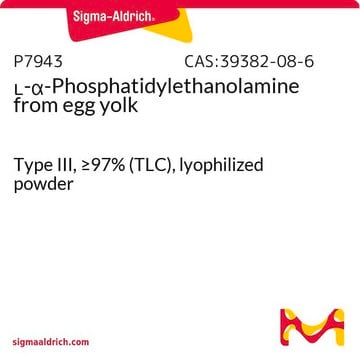P9511
3-sn-Phosphatidic acid sodium salt from egg yolk lecithin
≥98%
Synonyme(s) :
1,2-Diacyl-sn-glycero-3-phosphate sodium salt, L-α-Phosphatidic acid sodium salt, PA
About This Item
Produits recommandés
Pureté
≥98%
Forme
powder
Température de stockage
−20°C
Chaîne SMILES
[Na+].[Na+].OC[C@@H](O)COP([O-])([O-])=O
InChI
1S/C3H9O6P.2Na/c4-1-3(5)2-9-10(6,7)8;;/h3-5H,1-2H2,(H2,6,7,8);;/q;2*+1/p-2/t3-;;/m1../s1
Clé InChI
GEKBIENFFVFKRG-HWYNEVGZSA-L
Vous recherchez des produits similaires ? Visite Guide de comparaison des produits
Description générale
Application
- in the reaction mixture for CDS (cytidine triphosphate:phosphatidate cytidyltransferase) assay and reference lipid for thin layer chromatography (TLC)
- as a standard to compare the generated radiolabeled phosphatidic acid (PA)
- to examine its effects on At-Rac2–associated kinase activity
Actions biochimiques/physiologiques
Caractéristiques et avantages
Notes préparatoires
Code de la classe de stockage
11 - Combustible Solids
Classe de danger pour l'eau (WGK)
WGK 3
Point d'éclair (°F)
Not applicable
Point d'éclair (°C)
Not applicable
Équipement de protection individuelle
Eyeshields, Gloves, type N95 (US)
Certificats d'analyse (COA)
Recherchez un Certificats d'analyse (COA) en saisissant le numéro de lot du produit. Les numéros de lot figurent sur l'étiquette du produit après les mots "Lot" ou "Batch".
Déjà en possession de ce produit ?
Retrouvez la documentation relative aux produits que vous avez récemment achetés dans la Bibliothèque de documents.
Les clients ont également consulté
Articles
Cyclic nucleotides like cAMP modulate cell function via PKA activation and ion channels.
Discover Bioactive Small Molecules for Lipid Signaling Research
Notre équipe de scientifiques dispose d'une expérience dans tous les secteurs de la recherche, notamment en sciences de la vie, science des matériaux, synthèse chimique, chromatographie, analyse et dans de nombreux autres domaines..
Contacter notre Service technique









